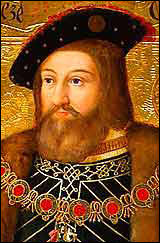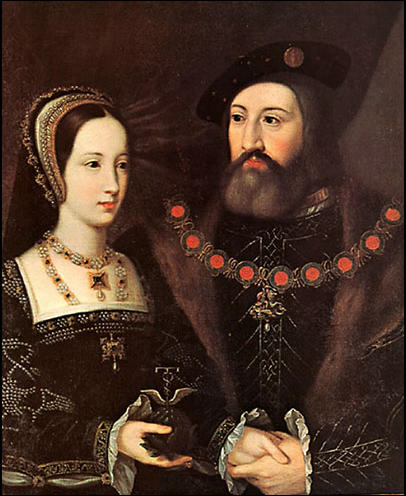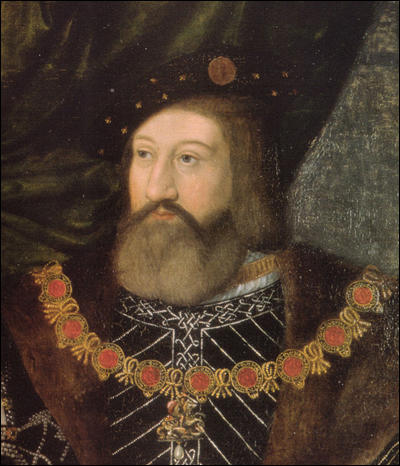Charles Brandon, 1st Duke of Suffolk

Charles Brandon, the second but only surviving son of Sir William Brandon and his wife, Elizabeth Bruyn of South Ockendon, was born in about 1484. His father was a loyal supporter of Henry VII and was killed at the Battle of Bosworth.
Brandon was a talented sportsman and jousted at the tournament to celebrate the marriage of Prince Arthur and Catherine of Aragon in 1501. According to his biographer, S. J. Gunn: "By about 1503 Charles Brandon waited on Henry VII at table and by 1507 he was an esquire for the body. More excitingly, by 1505–6 he was one of the company of king's spears, martial young gallants active in jousts and courtly display." (1)
Brandon had a complex series of relationships with women. "Brandon... was one of those big, handsome, straightforward Englishmen, apparently irresistible to women." (2) He was contracted to marry Anne Browne when she became pregnant. In the summer of 1506 he abandoned her to marry her widowed aunt, Dame Margaret Mortimer. He sold off some of her lands, making an estimated £1,000 before obtaining a divorce. Early in 1508 he secretly married Anne Browne. Soon afterwards she had his second child. Anne died shortly afterwards. Brandon also fathered three other illegitimate children. (3) David Starkey has commented that Brandon's "reputation (except on the jousting field and in bed) does not stand high." (4)
Charles Brandon & Henry VIII
Henry VII died on 22nd April, 1509. His son, Henry VIII, had long admired Brandon and on his accession he made Brandon and his friends central to the tournaments. In October 1512 he became master of the horse in succession to Thomas Knyvet, and therefore took over responsibility for the king's horses, hunting, and jousts. Stewardships of royal estates, keeperships of royal houses, and offices in Wales were all steadily added to his portfolio. He was created Viscount Lisle on 15th May 1513.
If you find this article useful, please feel free to share on websites like Reddit. You can follow John Simkin on Twitter, Google+ & Facebook or subscribe to our monthly newsletter.
Brandon served as High Marshal of the army, in charge of discipline. He was chosen to lead a landing force in the invasion of France. He took no great part in the fighting of the early part of the campaign, but at the Siege of Tournai he led a successful assault on one of the city gates which was instrumental in persuading the citizens to surrender it. When handed the keys of the city, the king passed them to Brandon, who led his troops in to occupy it. Soon afterwards Henry granted him the outlying castle of Mortain. He was also granted the title of the Duke of Suffolk.
Marriage to Mary Tudor
Brandon became close to Henry's sister, Mary Tudor. In 1514, the 18-year-old Mary married King Louis XII. After the king's death, on 1st January, 1515, Henry VIII asked him to escort Mary home. "An extraordinary sequence of events then followed. Charles Brandon was an attractive man with a complex, not to say unscrupulous, matrimonial history." (5) At Paris, in mid-February, without Henry's permission, they married. (6) Henry was angry at first but eventually forgave his great friend. On 13th May, 1515, they were married officially at Greenwich Palace. "Henry's displeasure was mollified by the surrender of Mary's jewels and plate, half her dowry... and a further £24,000 payable over twelve years from the profits of Mary's dower lands in France." (7)

Charles Brandon continued to take part in tournaments. In March 1524 he injured Henry VIII during a joust. Unfortunately the King forgot to put down his visor "before he started to thunder on his horse in the direction of his opponent". Suffolk's lance struck him and Henry fell heavily to the ground. "The trouble was that his visor filled with pieces of the splintered lance and it was a miracle that the King's sight was not affected. Suffolk immediately declared that he would never joust against the King again." Henry, however, admitted "no one was to blame but himself". (8)
In February 1529 ambassadors were naming Brandon as a leading opponent of Cardinal Thomas Wolsey. When he was removed from power in October, Brandon replaced him as Henry's leading councillor for which his status and the king's confidence fitted him, being appointed president of the king's council. As S. J. Gunn has pointed out "as the new regime settled down from 1530, his attendance in council and parliament was erratic, his influence limited, and his position uncomfortable." (9) His suffering increased with the death of his wife, Mary, on 25th June, 1533. (10)
In September 1533, Brandon married his ward Catherine Willoughby, aged fourteen. She had been betrothed to his son Henry Brandon, Earl of Lincoln, but the boy was only 10 years-old and considered too young to marry. He did not wish to risk losing Catherine's lands, so he married her himself. Antonia Fraser claimed that "time had not dimmed the sex appeal that made him the most desired man in the early Tudor court as he wielded his long lance at the joust, and Catherine, a girl of independent spirit as it turned out, did not object". Catherine gave birth to two boys over the next couple of years. (11)

Charles Brandon was one of Henry's leading councillors who was opposed to his proposed marriage to Anne Boleyn. (12) However, in December 1533 Charles Brandon was sent to visit Catherine of Aragon at Kimbolton Castle to tell her that Henry was about to marry Anne. It was a task that Brandon found distasteful. He told his mother-in-law that he hoped he would meet with an accident on the way that would prevent him from carrying out his orders. Catherine told him she would rather be torn in pieces than admit she was not the King's wife. "Suffolk told her he had come to escort her to Fotheringhay, at which - without further argument - she withdrew to her chamber and locked herself in. `If you wish to take me with you, you will have to break down the door!' she cried, and no threats or entreaties could persuade her to come out. Suffolk dared not force the door, or seize Katherine by force: she was the Emperor's aunt, and there would be repercussions. So he proceeded to the business of dismissing her servants, leaving only a few to care for her needs. Those remaining were ordered in the King's name to refer to their mistress in future as the Princess Dowager." (13)
Brandon suffered because of his "less than whole-hearted commitment to the Boleyn marriage". Henry and Anne inspected some of Brandon's properties which "were ear-marked for surrender to the Crown". When Brandon complained Henry replied "he of all men" should consider the "manifold benefits" he had received from him. Henry pointed out that as he had "advanced him to his honour and estate" he could just as easily undo him. (14)
Pilgrimage of Grace
Charles Brandon was brought out of retirement during the Pilgrimage of Grace crisis. In Yorkshire, in 1536, a lawyer named Robert Aske formed an army to defend the monasteries. The rebel army was joined by priests carrying crosses and banners. Leading nobles in the area also began to give their support to the rebellion. The rebels marched to York and demanded that the monasteries should be reopened. This march, which contained over 30,000 people, became known as the Pilgrimage of Grace.
Charles Brandon was sent to Lincolnshire to deal with the rebels. In a age before a standing army, loyal forces were not easy to raise. (15) "Appointed the king's lieutenant to suppress the Lincolnshire rebels, he advanced fast from Suffolk to Stamford, gathering troops as he went; but by the time he was ready to fight, the rebels had disbanded. On 16th October he entered Lincoln and began to pacify the rest of the county, investigate the origins of the rising, and prevent the southward spread of the pilgrimage, still growing in Yorkshire and beyond. Only two tense months later, as the pilgrims dispersed under the king's pardon, could he disband his 3600 troops and return to court." (16)
Henry VIII's army was not strong enough to fight the rebels in Norfolk. Thomas Howard, Duke of Norfolk, negotiated a peace with Aske. Howard was forced to promise that he would pardon the rebels and hold a parliament in York to discuss their demands. The rebels were convinced that this parliament would reopen the monasteries and therefore went back to their homes. (17)
However, as soon as the rebel army had dispersed. Henry ordered the arrest of the leaders of the Pilgrimage of Grace. About 200 people were executed for their part in the rebellion. This included Robert Aske and Lady Margaret Bulmer, who were burnt at the stake. Abbots of the four largest monasteries in the north were also executed.
Bishop Stephen Gardiner accepted these decisions but suggested that Henry followed a new policy of making concessions to his subjects. Henry's response was furious. He accused Gardiner of returning to his old opinions, and complained that a faction was seeking to win him back to their "naughty" views. (18)
Last Years
Charles Brandon was rewarded for his success during the Pilgrimage of Grace and he was recalled to court. He worked closely with Thomas Cromwell and served on the increasingly well-defined privy council. In 1539 he was appointed to the great mastership of the household, an upgraded version of the lord stewardship. He met Anne of Cleves on her arrival at Dover on 27th December 1539 and was head of the team which negotiated with her the terms of her divorce from the king in July 1540.
Suffolk's health was poor at times in the 1540s but this did not prevent his taking a major part in Henry's last wars against France and Scotland, while between campaigns he sat more regularly in the privy council than ever before, as a senior statesman and military expert. In October and November 1542 he guarded the northern border while Thomas Howard, Duke of Norfolk, and his army invaded Scotland. From January 1543 to March 1544 he was the king's lieutenant in the north. (19) By 1545 he was one of the richest men in England with an annual income of about £3,000.
Charles Brandon, 1st Duke of Suffolk, died in Guildford, on 22nd August 1545.
| Spartacus E-Books (Price £0.99 / $1.50) | ||||||
|---|---|---|---|---|---|---|
Primary Sources
(1) Alison Weir, The Six Wives of Henry VIII (2007)
To enforce her obedience, the Duke of Suffolk was sent to Buckden with a detachment of the King's guards. Suffolk did not relish his task. It was December, and he was reluctant to leave the warmth and splendour of a court preparing for Christmas and his bride of three months for a damp, lonely house on the Fens and a mission he found distasteful: harrying a sick woman. He told his mother-in-law, Lady Willoughby, that he hoped he would meet with an accident on the way that would prevent him from carrying out his orders. Unfortunately for the Duke, he arrived at Buckden on 18 December safe and sound, and entered almost immediately into a heated exchange with Katherine, who told him she would rather be torn in pieces than admit she was not the King's wife. This set the tone for the visit. Suffolk told her he had come to escort her to Fotheringhay, at which - without further argument - she withdrew to her chamber and locked herself in. `If you wish to take me with you, you will have to break down the door!' she cried, and no threats or entreaties could persuade her to come out.
Suffolk dared not force the door, or seize Katherine by force: she was the Emperor's aunt, and there would be repercussions. So he proceeded to the business of dismissing her servants, leaving only a few to care for her needs. Those remaining were ordered in the King's name to refer to their mistress in future as the Princess Dowager.
(2) Antonia Fraser, The Six Wives of Henry VIII (1992)
Publicly, the King's demeanour was as gallant and charming as ever. In March 1524 a most disquieting incident had taken place which, with the succession question unsolved, sent a shiver of apprehension through the court. The King was jousting with the Duke of Suffolk, as they had done so many times before, when by an appalling mischance, his face was left "clean naked", that is to say, his visor had not been put down, before he started to thunder on his horse in the direction of his opponent. The horror of those watching may be imagined. There were cries of "Hold, hold" but the King could not hear. Suffolk's lance struck him and King Henry fell heavily to the ground.
His weight was not the problem. (Although the King's armour for the Field of Cloth of Gold four years earlier shows a natural increase of a few inches in girth over that of 1514, his major weight gain lay ahead.) The trouble was that his visor filled with pieces of the splintered lance and it was a miracle that the King's sight was not affected. Suffolk immediately declared that he would never joust against the King again. Henry VIII, however, with princely grace, readily forgave the two men who had handed him his spear without his visor being down: "no one was to blame but himself". Despite his shaken state, he proceeded to take a spear and run six courses, in order to reaccure the spectators that he had not been hurt.
Student Activities
Henry VIII (Answer Commentary)
Henry VII: A Wise or Wicked Ruler? (Answer Commentary)
Henry VIII: Catherine of Aragon or Anne Boleyn?
Was Henry VIII's son, Henry FitzRoy, murdered?
Hans Holbein and Henry VIII (Answer Commentary)
The Marriage of Prince Arthur and Catherine of Aragon (Answer Commentary)
Henry VIII and Anne of Cleves (Answer Commentary)
Was Queen Catherine Howard guilty of treason? (Answer Commentary)
Anne Boleyn - Religious Reformer (Answer Commentary)
Did Anne Boleyn have six fingers on her right hand? A Study in Catholic Propaganda (Answer Commentary)
Why were women hostile to Henry VIII's marriage to Anne Boleyn? (Answer Commentary)
Catherine Parr and Women's Rights (Answer Commentary)
Women, Politics and Henry VIII (Answer Commentary)
Cardinal Thomas Wolsey (Answer Commentary)
Historians and Novelists on Thomas Cromwell (Answer Commentary)
Martin Luther and Thomas Müntzer (Answer Commentary)
Martin Luther and Hitler's Anti-Semitism (Answer Commentary)
Martin Luther and the Reformation (Answer Commentary)
Mary Tudor and Heretics (Answer Commentary)
Joan Bocher - Anabaptist (Answer Commentary)
Anne Askew – Burnt at the Stake (Answer Commentary)
Elizabeth Barton and Henry VIII (Answer Commentary)
Execution of Margaret Cheyney (Answer Commentary)
Robert Aske (Answer Commentary)
Dissolution of the Monasteries (Answer Commentary)
Pilgrimage of Grace (Answer Commentary)
Poverty in Tudor England (Answer Commentary)
Why did Queen Elizabeth not get married? (Answer Commentary)
Francis Walsingham - Codes & Codebreaking (Answer Commentary)
Codes and Codebreaking (Answer Commentary)
Sir Thomas More: Saint or Sinner? (Answer Commentary)
Hans Holbein's Art and Religious Propaganda (Answer Commentary)
1517 May Day Riots: How do historians know what happened? (Answer Commentary)




